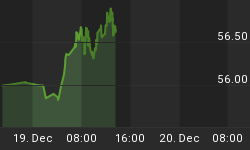I posted an article on Friday, stating that the stock market still had a bullish bias, but that breadth was deteriorating. Breadth indicators are also useful tools to assess the inner workings of the market's rallies or corrections, and are used to identify strength or weakness behind market moves such as the nascent rally, i.e. to assess how the bulls and the bears are exerting themselves.
Let's consider a specific measure of stock market "internals": The number of S&P 500 stocks trading above their respective 50-day moving averages has declined to 80% from 93% in October (see bottom panel of the chart below). In order to be bullish about the secondary trend, one would expect the majority of stocks to be above the 50-day line.
However, the fact that fewer stocks are now above their 50-day moving averages than in October means that a smaller number of stocks are participating in the rally. In the meantime, the S&P 500 has been scaling new highs for the move. This is known as a so-called bearish divergence - a phenomenon investors should be mindful of, especially given the overbullish sentiment levels.

Source: StockCharts.com
The bulk of the index constituents, 86.4%, are trading comfortably above their 200-day averages. As long as this number holds above 50%, a primary bull market remains intact. However, a short-term reaction to clear some of the froth is likely and should be factored into investors' decision-making.
John Hussman (Hussman Funds) summarized the situation as follows: "In short, it's not impossible that specific features of the current market could make investors more tolerant of rich valuations, or more careful to demand conservative ones. Regardless, my impression is that a decade from today, investors will view the present time as a relatively undesirable moment to put investment capital at risk."
Did you enjoy this post? If so, click here to subscribe to updates to Investment Postcards from Cape Town by e-mail.















